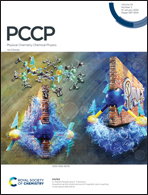Deciphering the mechanism of action of 5FDQD and the design of new neutral analogues for the FMN riboswitch: a well-tempered metadynamics simulation study†
Abstract
The FMN riboswitch is a novel drug target for the design of new antibiotics, and efforts have been made to design new charged and uncharged ligands. Uncharged ligands have shown advantages of not requiring any transporter for intracellular transport or proteins for their phosphorylation. 5FDQD (5-(3-(4-fluorophenyl)butyl)-7,8-dimethylpyrido(3,4-b)quinoxaline-1,3(2H,5H)-dione) is a recently reported neutral ligand for the FMN riboswitch active against Clostridium difficile infection in mice. However, the crystal structure of the 5FDQD bound FMN riboswitch is not available, and the mechanism of ligand binding and triggering the function of the riboswitch is not well understood. We have examined 5FDQD for its binding affinity with the FMN riboswitch using the well-tempered metadynamics (WT-MtD) simulation technique. The crystal structure of the FMN riboswitch shows that the FMN interacts with the J4/5 region through the phosphate group with G62; however, the uncharged ligands take advantage of π–π stacking interactions with the same residue of the riboswitch observed from the WT-MtD simulation results. The simulation results show that the presence of fluorine on the phenyl ring in 5FDQD is important to enhance the binding affinity of the neutral ligands with the FMN riboswitch. The WT-MtD results showed that the 1,2-difluoro substitution on the phenyl ring in 5FDQD (FMN-difluoro2) and the 1,3 positions in the phenyl ring (FMN-difluoro1) showed weaker binding energy with the FMN riboswitch compared to 5FDQD. The substitution of another fluorine atom at the 5-position of the phenyl ring (FMN-trifluoro) showed a comparable binding affinity (∼−31.4 kcal mol−1) to 5FDQD. Electron-donating substitution on the phenyl ring such as the amino group also lowered the binding affinity (−28.8 kcal mol−1) with the riboswitch compared to 5FDQD. The computed results suggest that the position and nature of substitution in the phenyl ring of the uncharged ligands affect the overall binding and such a delicate balance is important to achieve superior binding affinity with the FMN riboswitch.



 Please wait while we load your content...
Please wait while we load your content...